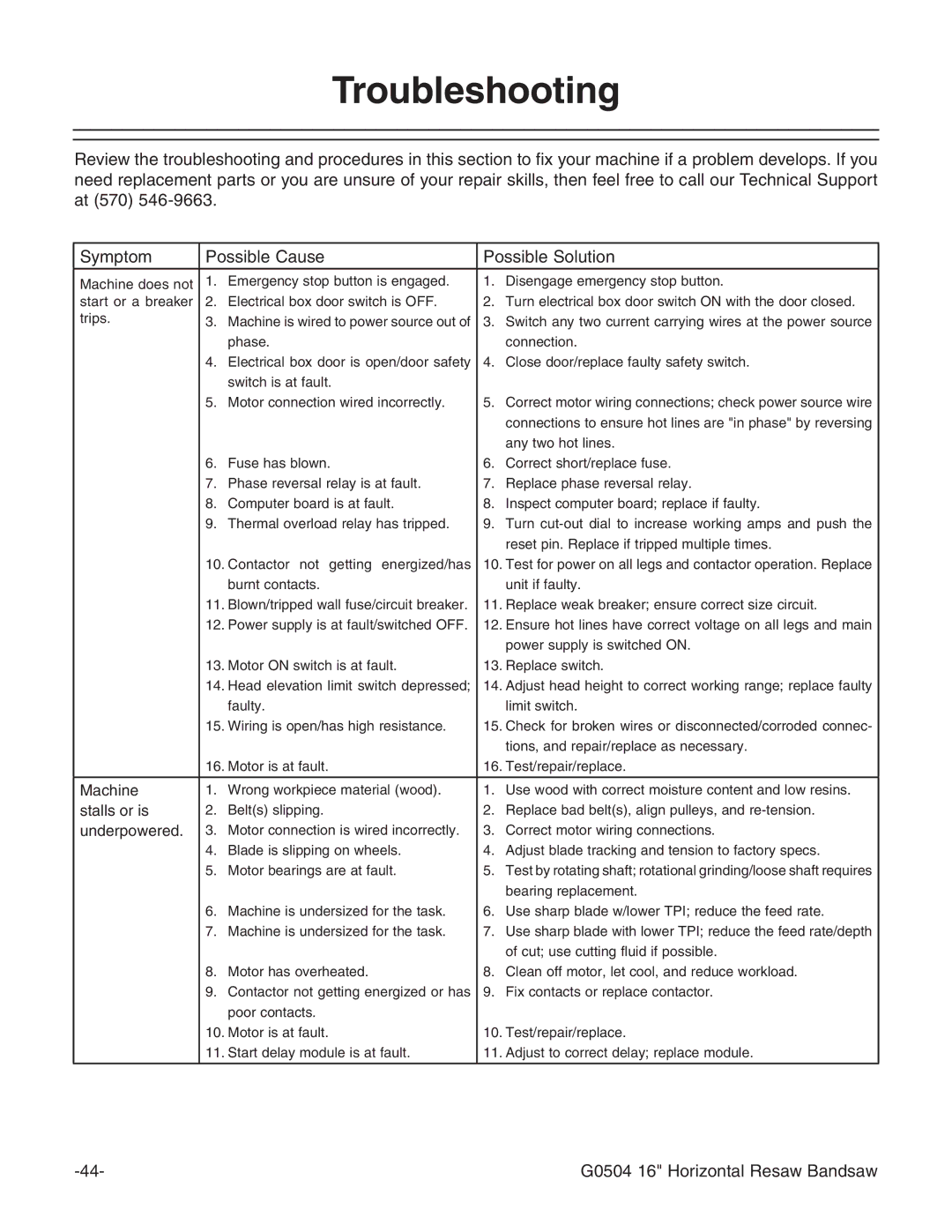Troubleshooting
Review the troubleshooting and procedures in this section to fix your machine if a problem develops. If you need replacement parts or you are unsure of your repair skills, then feel free to call our Technical Support at (570)
Symptom | Possible Cause | Possible Solution | ||
|
|
|
|
|
Machine does not | 1. | Emergency stop button is engaged. | 1. | Disengage emergency stop button. |
start or a breaker | 2. | Electrical box door switch is OFF. | 2. | Turn electrical box door switch ON with the door closed. |
trips. | 3. | Machine is wired to power source out of | 3. | Switch any two current carrying wires at the power source |
|
| phase. |
| connection. |
| 4. | Electrical box door is open/door safety | 4. | Close door/replace faulty safety switch. |
|
| switch is at fault. |
|
|
| 5. | Motor connection wired incorrectly. | 5. | Correct motor wiring connections; check power source wire |
|
|
|
| connections to ensure hot lines are "in phase" by reversing |
|
|
|
| any two hot lines. |
| 6. | Fuse has blown. | 6. | Correct short/replace fuse. |
| 7. | Phase reversal relay is at fault. | 7. | Replace phase reversal relay. |
| 8. | Computer board is at fault. | 8. | Inspect computer board; replace if faulty. |
| 9. | Thermal overload relay has tripped. | 9. | Turn |
|
|
|
| reset pin. Replace if tripped multiple times. |
| 10. Contactor not getting energized/has | 10. Test for power on all legs and contactor operation. Replace | ||
|
| burnt contacts. |
| unit if faulty. |
| 11. Blown/tripped wall fuse/circuit breaker. | 11. Replace weak breaker; ensure correct size circuit. | ||
| 12. Power supply is at fault/switched OFF. | 12. Ensure hot lines have correct voltage on all legs and main | ||
|
|
|
| power supply is switched ON. |
| 13. Motor ON switch is at fault. | 13. Replace switch. | ||
| 14. Head elevation limit switch depressed; | 14. Adjust head height to correct working range; replace faulty | ||
|
| faulty. |
| limit switch. |
| 15. Wiring is open/has high resistance. | 15. Check for broken wires or disconnected/corroded connec- | ||
|
|
|
| tions, and repair/replace as necessary. |
| 16. Motor is at fault. | 16. Test/repair/replace. | ||
|
|
|
|
|
Machine | 1. | Wrong workpiece material (wood). | 1. | Use wood with correct moisture content and low resins. |
stalls or is | 2. | Belt(s) slipping. | 2. | Replace bad belt(s), align pulleys, and |
underpowered. | 3. | Motor connection is wired incorrectly. | 3. | Correct motor wiring connections. |
| 4. | Blade is slipping on wheels. | 4. | Adjust blade tracking and tension to factory specs. |
| 5. | Motor bearings are at fault. | 5. | Test by rotating shaft; rotational grinding/loose shaft requires |
|
|
|
| bearing replacement. |
| 6. | Machine is undersized for the task. | 6. | Use sharp blade w/lower TPI; reduce the feed rate. |
| 7. | Machine is undersized for the task. | 7. | Use sharp blade with lower TPI; reduce the feed rate/depth |
|
|
|
| of cut; use cutting fluid if possible. |
| 8. | Motor has overheated. | 8. | Clean off motor, let cool, and reduce workload. |
| 9. | Contactor not getting energized or has | 9. | Fix contacts or replace contactor. |
|
| poor contacts. |
|
|
| 10. Motor is at fault. | 10. Test/repair/replace. | ||
| 11. Start delay module is at fault. | 11. Adjust to correct delay; replace module. | ||
|
|
|
|
|
G0504 16" Horizontal Resaw Bandsaw |
